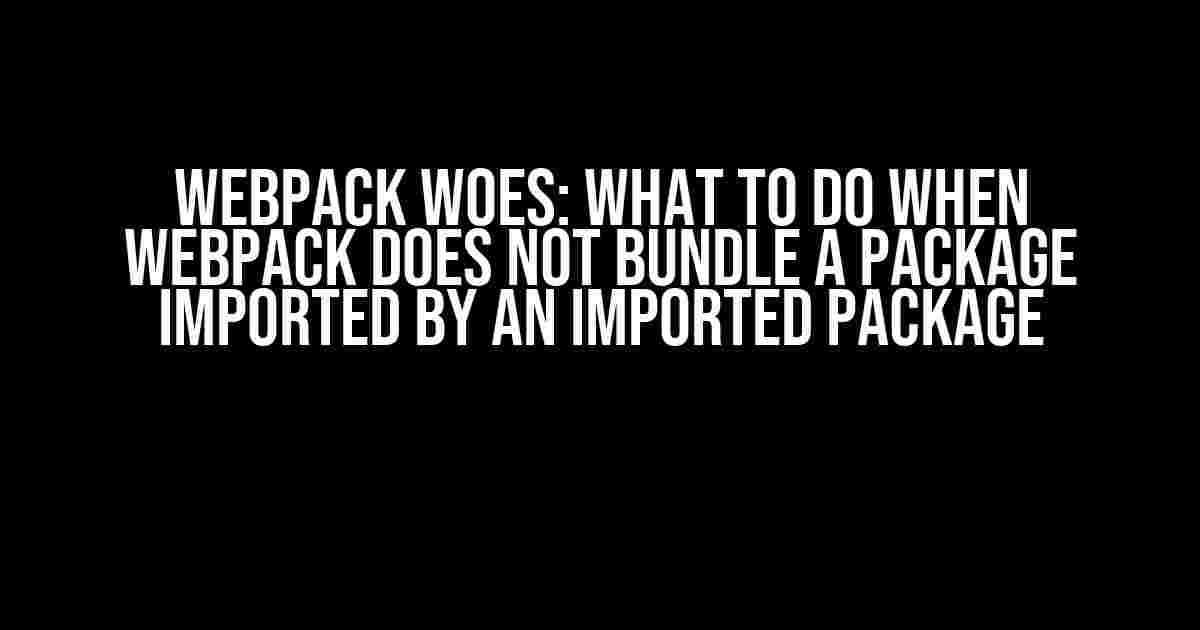Are you stuck in the infamous Webpack limbo, where your carefully crafted code is left unbundled and confused? You’re not alone! In this article, we’ll tackle the common gotcha of Webpack not bundling a package imported by an imported package. Buckle up, friend, and let’s dive into the solutions!
What’s the Problem, Anyway?
Before we dive into the fixes, let’s understand what’s happening. Webpack is a majestic creature, but even the best of us can get confused. When Webpack doesn’t bundle a package imported by an imported package, it’s usually due to one of two reasons:
- Webpack doesn’t understand the import path
- Webpack is being lazy and not resolving the import correctly
DON’T WORRY, WE’VE ALL BEEN THERE! With a clear understanding of the problem, we can start tackling the solutions.
Solution 1: Check Your Import Paths
Webpack can get finicky with import paths. Make sure you’re using the correct path to import the package. Double-check that you’re not using a relative path when you mean to use an absolute path, or vice versa.
import myPackage from '../node_modules/my-package'; // WRONG!
import myPackage from 'my-package'; // RIGHT!In this example, we’re using an absolute path by importing directly from the package name. If you’re still having trouble, try using a tilde (~) to specify the package path:
import myPackage from '~/node_modules/my-package';Bonus Tip: Use the `resolve` Option
If you’re still having trouble, try specifying the `resolve` option in your Webpack configuration. This tells Webpack to look for modules in specific directories.
module.exports = {
// ...
resolve: {
modules: ['node_modules']
}
};This tells Webpack to look for modules in the `node_modules` directory. You can add more directories to this array as needed.
Solution 2: Make Webpack Work Harder
Sometimes, Webpack needs a little encouragement to resolve imports correctly. You can try one or both of the following:
1. Use the `module.noParse` Option
By default, Webpack doesn’t parse dependencies in certain modules (like those in `node_modules`). If your imported package is in `node_modules`, try adding it to the `module.noParse` option:
module.exports = {
// ...
module: {
noParse: /my-package/
}
};This tells Webpack to parse the `my-package` module, even if it’s in `node_modules`.
2. Use the `module.rules` Option
If the above solution doesn’t work, you can try specifying a rule for the imported package using the `module.rules` option:
module.exports = {
// ...
module: {
rules: [
{
test: /my-package/,
use: 'imports-loader'
}
]
}
};This tells Webpack to use the `imports-loader` loader for the `my-package` module. You can customize this loader to fit your needs.
Solution 3: Use a Bundle Analyzer
Sometimes, the issue lies not with Webpack, but with our own code. A bundle analyzer can help you identify which packages are being imported and how they’re being resolved.
One popular bundle analyzer is Webpack-Bundle-Analyzer. You can install it via npm or yarn:
npm install webpack-bundle-analyzer --save-devThen, add it to your Webpack configuration:
const BundleAnalyzerPlugin = require('webpack-bundle-analyzer').BundleAnalyzerPlugin;
module.exports = {
// ...
plugins: [
new BundleAnalyzerPlugin()
]
};This will generate a detailed report of your bundle, including which packages are being imported and how they’re being resolved.
Solution 4: Check for Circular Dependencies
Circular dependencies can cause Webpack to get confused. If you have a circular dependency in your code, Webpack might not be able to resolve the import correctly.
To identify circular dependencies, you can use tools like Madge or Dependency Cruiser. These tools will help you visualize your dependency graph and identify any circular dependencies.
Once you’ve identified the circular dependency, refactor your code to eliminate it. This might involve breaking up large modules or reorganizing your imports.
Solution 5: Check for Version Conflicts
Version conflicts can also cause Webpack to get confused. If you’re using multiple versions of the same package, Webpack might not know which one to use.
Check your `package.json` file to ensure that you’re not using multiple versions of the same package. If you are, try pinning the version number or using a package like `npm-aliases` to manage your dependencies.
Conclusion
Webpack not bundling a package imported by an imported package can be a frustrating issue, but fear not! With these solutions, you should be able to identify and fix the problem. Remember to check your import paths, make Webpack work harder, use a bundle analyzer, check for circular dependencies, and resolve version conflicts.
WEBPACK, YOU GOT THIS!
| Solution | Description |
|---|---|
| Check Import Paths | Verify that import paths are correct and absolute |
| Make Webpack Work Harder | Use the `resolve` option or specify a rule for the imported package |
| Use a Bundle Analyzer | Identify which packages are being imported and how they’re being resolved |
| Check for Circular Dependencies | Identify and refactor circular dependencies in your code |
| Check for Version Conflicts | Verify that you’re not using multiple versions of the same package |
Happy coding, and may the Webpack be with you!
Frequently Asked Question
Get the lowdown on why Webpack doesn’t bundle that package imported by another package – because we’ve got the answers!
Why doesn’t Webpack bundle the package imported by another package?
Webpack only bundles modules that are directly imported by your application code. If a package is imported by another package, Webpack won’t include it in the bundle unless it’s explicitly imported somewhere in your code. Think of it like a “need-to-know” basis – if your code doesn’t need it, Webpack won’t bother including it!
But I’ve seen it work before! What gives?
That’s a great observation! It’s possible that the package was imported somewhere else in your code, or that the imported package has its own dependencies that are being bundled. It’s also possible that Webpack was configured to include the package explicitly. So, don’t worry, you’re not going crazy – it’s just Webpack being its usual efficient self!
How can I make Webpack bundle the package I need?
Easy peasy! Simply import the package directly in your application code, and Webpack will take care of the rest. If you’re using a plugin or library that relies on the package, make sure to configure it correctly to include the package in the bundle. And if all else fails, you can always use the ` CommonsChunkPlugin` or `dll-webpack-plugin` to include the package explicitly.
What if I’m using a package manager like npm or yarn?
No worries there! When you install a package using npm or yarn, it gets added to your project’s `node_modules` directory. Webpack will still only bundle modules that are directly imported by your application code, but you can rest assured that the package is available for use.
Is this behavior specific to Webpack, or is it a general JavaScript thing?
This behavior is actually a result of how JavaScript modules work. In JavaScript, modules are only executed when they’re explicitly required or imported. Webpack is simply respecting that behavior when it comes to bundling modules. So, it’s not just a Webpack thing – it’s a fundamental aspect of how JavaScript modules work!








